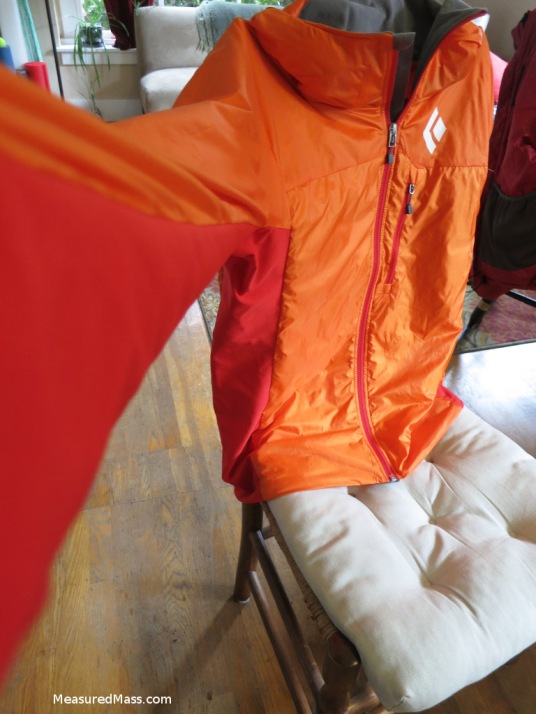Black Diamond Access LT Hybrid Hoody
A curious jacket. Light, breathable, and kinda warm.
Creative construction makes it notable.
The BD Access LT Hoody was (and is) on sale recently, when I was on a hunt for a lightweight puffy jacket. The Patagonia Nanopuff was on sale in the same sale at comparable price, but without a hood; a dealbreaker for me.
The Access LT is warm where it’s insulated, and very breathable along the sides and below the arms, where there’s a wide strip of un-insulated softshell material. It is this breathable strip that defines the jacket; it makes it inappropriate as a single-piece shiver-bivy tool, but it expands considerably the range of activities over which it can be worn.
I’ve only had one three-day trip with it so far (camping and skiing from 5-10,000′ in Oregon), where I paired it with a thicker softshell as extra insulation in camp, which worked out well. The jacket holds its own in the wind, but doesn’t stop it completely. The hood is warm and fits above and below helmets with ease. While climbing in temperatures of ~30-50F with a 20-50 mph wind (yes, breezy!) and conditions from bright sunshine to clouds, the jacket was a useful partner. The breathable strips can be chilly when you’re cold, but they’re great if you’re too hot. They’re efficient-enough at dumping heat that spreading your arms into a breeze has papable effect.
The DWR treatment on this fabric is impressive. While the jacket is not water-resistant, a drop of water beads on the surface with an amazing contact angle. Droplets and drops simply roll about on the surface of the material. Better living through chemistry; this repellent surface should help with breathability.
The outer surface is smooth, but the inner surface is quilted. After I set my pack down in the ash of a recent forest fire, the resultant rubbing stain hasn’t easily washed out of the bright orange material.
The jacket feels gosssamer light. How light?
383 grams, in size large. BD claims 360 grams, but doesn’t quote a size. I can’t quote an uncertainty, as I don’t have two jackets :).
Conclusions: This is a mid/lightweight jacket. If you need a belay jacket for the apocalypse, this isn’t it. This jacket is best viewed as a useful lightweight insulating layer that breathes well and has a great hood. I’ll be bringing it along on spring ski trips, summer climbing trips, and partway into autumn. On fast trips near the car in winter, I may succumb to it’s light weight; we’ll see. Pair it with a windblocking shell for a jump in warmth.
Edit 12/3/2014: I’ve gotten the jacket out on a winter trip now, with temperatures in the teens Fahrenheit with blowing snow falling from trees. It’s a great layer, as it seems to be both warm and breathable. It’s going to see a lot more trips this year in a capacity where I might have worn a fleece in the past. Bring a real puffy as your survival tool, though. I’ll update again as the season progresses, as traffic to this review indicates general interest in the jacket.
Edit 9/28/2015: This jacket has become a regular in my pack. In summer, it and a heavier shell form my entire complement of (lightweight) insulation. In winter, it’s completely displaced the fleece; shell, Dawn Patrol hoody, big puffy. The temperature range of the jacket is considerable. It won’t keep you warm at a shiver bivy, though. The jacket has held up well; one tiny rip, and the insulation is starting to pack out. The jacket easily has at least another busy year in it before it’s diminished enough to consider replacement. And, as always, I love the color. No need for a blaze orange hunting vest when hiking in autumn, and my partners can easily find me in low-visibility conditions. Bueno.



